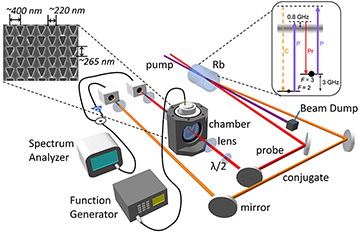 Experimental setup. A four-wave-mixing process (right inset) generates entangled probe and conjugate beams. The probe beam serves as a probe for the plasmonic sensor (left inset) while the conjugate beam serves as a quantum-correlated reference. [Image adapted from reference 2.] [Enlarge figure]
Experimental setup. A four-wave-mixing process (right inset) generates entangled probe and conjugate beams. The probe beam serves as a probe for the plasmonic sensor (left inset) while the conjugate beam serves as a quantum-correlated reference. [Image adapted from reference 2.] [Enlarge figure]
The ultimate sensitivity of any optically based measurement using classical resources (for example, laser or thermal light) is constrained by the photon shot noise limit (SNL). However, quantum states of light, in which photon pairs have quantum correlations or entanglement, offer a path beyond this limit. In particular, “squeezing” in these quantum states makes it possible to lower the noise in the detection system below the SNL. This can significantly enhance the sensitivity of real-world devices and could thus revolutionize optical-based sensing applications.1
Recently, we demonstrated the first quantum-enhanced plasmonic sensor with a sensitivity comparable to the classical state of the art.2 The plasmonic sensors we use are based on extraordinary optical transmission (EOT),3 a coherent photon-plasmon-photon conversion that maintains the light’s quantum properties.4 These sensors respond to local changes in refractive index, can be optically probed, and are widely used in biosensing and medical diagnostics.
The plasmonic structure used as a sensor consists of an array of subwavelength triangular holes in a 100-nm-thin silver film. We interface this structure with quantum states of light generated through four-wave mixing in hot 85Rb atoms. This process generates probe and conjugate beams that exhibit continuous-variable entanglement and 9 dB of intensity-difference squeezing, equivalent to a noise level 87 percent below the SNL.
The reduced noise allows us to detect signals that would otherwise be buried by the shot noise and thus obtain a quantum enhancement in sensitivity. We demonstrated a refractive-index sensitivity of 5.5 × 10–10 RIU/Hz½ with the quantum states of light, a 56 percent enhancement relative to the 8.6 × 10–10 RIU/Hz½ SNL for the system without quantum noise reduction. These sensitivities are comparable to the current state of the art with classical resources for plasmonic sensors, and represent an improvement of five orders of magnitude with respect to initial demonstrations of quantum plasmonic sensors.5
These results can offer significant advances in plasmonic sensing for high-precision biomedical and biochemical detection schemes. Because plasmonic sensors are currently limited by the SNL, squeezed readout fields will enable the detection of molecules whose signatures were previously obscured by quantum noise.
Researchers
Mohammadjavad Dowran, Ashok Kumar and Alberto M. Marino, University of Oklahoma, Norman, Okla., USA
Benjamin J. Lawrie and Raphael C. Pooser, Oak Ridge National Laboratory, Oak Ridge, Tenn., USA
References
1. C.L. Degen et al. Rev. Mod. Phys. 89, 035002 (2017).
2. M. Dowran et al. Optica 55, 628 (2018).
3. T.W. Ebbesen et al. Nature 391, 667 (1998).
4. M.W. Holtfrerich et al. Optica 3, 985 (2016).
5. R.C. Pooser and B. Lawrie. ACS Photon. 3, 8 (2015).

